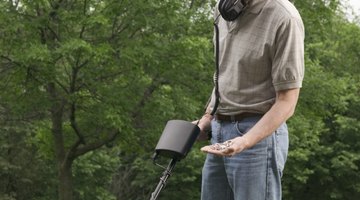How to Locate Copper Pipes Underground Without Breaking Up the Cement
When performing outdoor plumbing work or other digging projects that may affect pipes underground, it's important to know where the pipes are and aren't. One way to find copper pipes without busting up concrete or accidentally running into pipes while digging through dirt is to use a metal detector.

Many metal detectors have settings that allow you to determine what type of metal is being detected. For instance, if you want to find only copper pipes, there's a copper setting that will tune out everything else. Metal detecting can help prevent costly accidents because you'll be sure where the copper pipes lie before proceeding with your project.
Things You Will Need
- Metal detector
- Coins
- Keychain
- Golf tees
- Chalk
Tip
Metal detectors run the gamut in price from inexpensive, toylike devices to pricey fine-tuned gadgetry meant for serious detector enthusiasts. Any metal detector that has a discrimination setting -- a dial or button that allows you to choose to find only certain metal types -- will find copper pipes. A pipe that is buried several feet underground may not be detected easily, if at all. Metal detecting works best with pipes buried less than 2 feet deep. Underground moisture helps increase the conductivity of metals such as buried pipes, so if you're having a hard time finding pipes with a detector, try again after a good rain. If the detector doesn't find anything specifically determined to be copper, set the detector to find all metal types. You'll be able to tell when you've found a pipe by the size and length of the area creating a signal on your detector. Keep the detector coil horizontal and parallel to the ground at all times during use.
Warning
Moving the detector too quickly or with jerky motions could produce false readings.
There is often metal within concrete that is used to give the concrete strength. This metal may produce a reading on your detector, making it hard to detect pipes beneath the concrete. If this happens, detect in areas where the pipes may run under dirt rather than beneath concrete slabs. Then you can trace the path the pipe follows beneath concrete or other manmade structures.
-
Practice using the metal detector to learn the meanings of its various beeps and visual indicators. Place coins of various denominations several feet apart outside, as well as a keychain or other small metal objects. Turn on the detector and wave it gently over one of the coins, noting the tones the detector produces.
-
Wave the detector coil over the other coins, one at a time, to note the beeps or visual indications given by the detector. Move the detector coil above the keychain or other metal object and note the detector's tones. Continue practicing until you are familiar with operating the detector, consulting the manual when necessary.
-
Move the detector over ground where you believe the pipes are buried. Search first in areas not covered by concrete for more accurate readings. (See note in Warnings section.) If you aren't hearing any tones from the detector, turn up the detector's sensitivity setting and set it to find just copper. If there is no such setting on your detector, set it to detect all metals.
-
Continue waving the detector over areas of ground until you find an area that produces signals in a straight line, which would indicate a pipe. Place golf tees in the area of the line, if detecting over dirt, to mark your pipe for future reference. If over concrete, mark the pipe area with chalk.
The Drip Cap
- When performing outdoor plumbing work or other digging projects that may affect pipes underground, it's important to know where the pipes are and aren't.
- Move the detector over ground where you believe the pipes are buried.
- See note in Warnings section.) If there is no such setting on your detector, set it to detect all metals.
Resources
Writer Bio
Kathy Adams is an award-winning writer. She is an avid DIYer that is equally at home repurposing random objects into new, useful creations as she is at supporting community gardening efforts and writing about healthy alternatives to household chemicals. She's written numerous DIY articles for paint and decor companies, as well as for Black + Decker, Hunker, Landlordology, SFGate and others.
Photo Credits
- Jupiterimages/liquidlibrary/Getty Images
- Jupiterimages/liquidlibrary/Getty Images
More Articles



